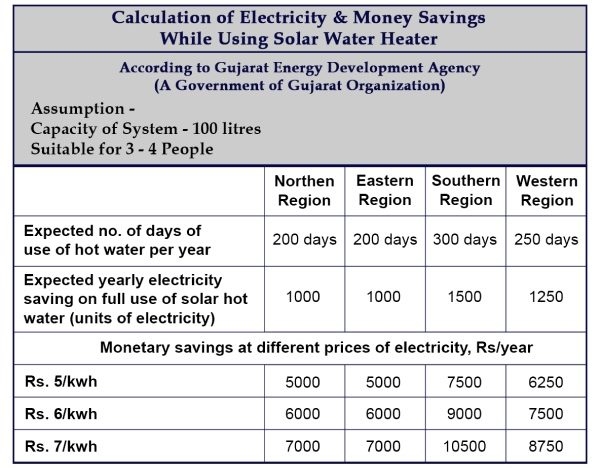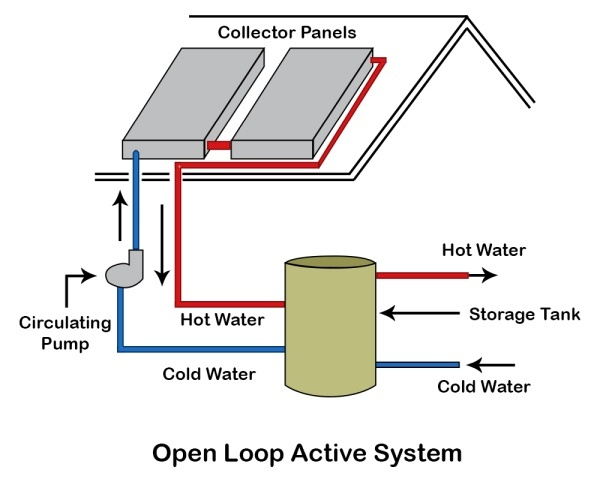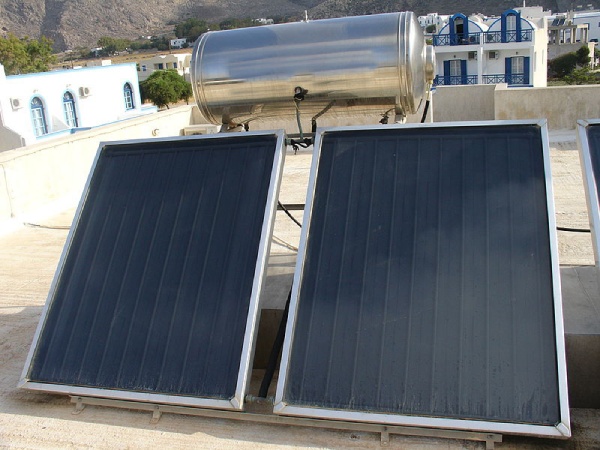
The scarcity of oil and the swelling cost of oil, gas and electricity have focused attention on the need for a transition to the renewable energy sources. Solar energy – one such renewable energy resources, plays a pivotal role in this effort, particularly for domestic water heating.
One of the popular devices that harness solar energy is the solar water heater. There are different types of domestic solar hot water systems available for heating water. Therefore, the choice can be confusing.
So then, how to identify a good solar water heater? Well, it is simple!
A Good solar water heater not only reduces the fuel and electricity cost, but it also offers several benefits. Please visit this blog before making an initial investment in the solar water heater. The content of this blog will help you in determining the type of solar system that would be the best for your home.
What is a Solar Water Heater?
The solar water heater is a device which is used for heating the water for domestic application by utilizing solar energy. Solar energy is the energy which is available from the sun in the form of solar radiations in an infinite amount. When these solar radiations fall on any absorbing surface, they get converted into heat. This heat is used for heating the water.
How does a Solar Water Heater Function?
A Solar Water Heater consists of an array of solar collectors to collect solar energy along with an insulated tank to store the hot water. Both are connected to each other. During the day time, water in the solar collectors gets heated, which is either pumped in or it flows automatically to the storage tank as per the thermosiphon principle. Hot water is then stored in the tank which can be used for various purposes like bathing, washing, and cleaning etc.
Benefits of a Solar Water Heater
- It reduces carbon footprint.
- It is an environment friendly appliance.
- It is a money saver.
- It offers long term benefits which goes beyond simple economics. In addition to having free hot water after the system has paid for itself in reduced utility bills, you will be safe from future fuel shortages.
- It is useful in sustaining natural resources.
How Much Money and Electricity Can a Solar Water Heater Save?
Depending upon the quantity of hot water used, a 100 litre per day capacity solar water heating system can save up to 1500 units of electricity in a year. The table below gives the approximate calculation of electricity and money saving for 100 litres per day system located in different regions.

In How Much Time Can You Recover Your Investment on a Solar Water Heater?
Generally, the recovery of your investment depends upon the fuel replaced, utilization pattern and your selection of the heater, i.e. type and size of the system. With a 100 litres per day system, you can recover your investment within,
- 3 – 4 years if you replace electric water heaters.
- 4 – 6 years if you replace gas water heaters.
Also, your recovery is directly proportional to the cost of gas and electricity.
If you want to study in-depth and comprehensively about recovering your investment in the solar water heater, please refer
Selection of A Good Solar Water Heater
Before you purchase and install a solar water heating system, please make sure of the following:
- Work out the economics of the solar water-heating system
- Evaluate the solar resource of your site i.e. availability of the Sun for the number of days, the direction in which the sunlight is available and the location where the installation is feasible.
- Determine the accurate system size
- Gather information on local codes, regulations and subsidies, tax exemption etc., available.
- Get comparative offers from more than one manufacturer; compare their specifications and vis-à-vis cost. Also check their reputation, brand and study the feedback pertaining to their after sales support and service from the actual users.
You can take a look for great solar water heater by Liter of Light USA from quality aspects.
Factors to Be Considered While Selecting the Best Solar Water Heater
01. Is your house suitable for the solar water heater?
Solar water heaters are installed on the roof. Thus, the location of your roof is important. For best result, your roof should be south facing and receiving abundant sunlight between 10 AM to 4 PM. Basically you will require 2m X 3m = 6 sq. m of space for installing 100 to 200 litre system.
02. What is your budget on the solar water heater?
The cost of a solar water heater depends on several factors like,
- The capacity of solar water heater.
- The material used in the internal and external tanks.
- The length of pipes needed for the distribution of water.
The above points must be kept in mind while determining the budget for the solar water heater.
03. Decide the size of the Solar Water Heater
The capacity of the solar water heater will depend upon the requirement of hot water on daily basis. Domestic hot water use depends on various factors like,
- Number of people living in your house, their age and life style
- Number of bathrooms in your house
- Number of visitors staying at your home
Basically, 100 litre to 500 litre capacity of solar water heater is suitable for domestic hot water application. Solar water heaters above 500 litres capacity are suitable for hotels, guest house, hospitals etc. Normally for a family of 4 members, 100 litre would be sufficient.
For more detail Read:
04. Approximate Cost of a Solar Water Heater
As per guidelines given by Gujarat Energy Development Agency (A Government of Gujarat Organization), the 100-litre capacity system is sufficient for a family of 3 – 5 members. The approximate cost of 100 litres per day system is between Rs. 15,000 -Rs. 22,000 depending upon the type of system. In the cold regions or places having low temperature i.e. North India, north-East Indiaor hilly regions, the price can be 15 % to 20 % more.
The system cost does not include the cost of the storage tank (if not installed at your home), pipeline etc. Additional cost towards all these components can increase approximately by 5 to 15%.
Also, for the cost and maintenance requirements, you can refer the article
05. Collector Area of a Solar Water Heater
A best solar water heater must have sufficient collector area. For example, on a sunny winter day in India, 1 sq. m. of collector area can heat around 50 litres of water to a temperature of 30-600C. Typical flat plate collectors that are generally available having an area of around 2 sq. m are capable of heating 100 litres of water per day.
06. Make sure that a Good Quality Solar Water Heating System is installed at your Home
Ministry of New and Renewable Energy (Government of India) has laid down some technical requirements for the installation of solar water heating system in the field. These are mandatory for manufactures and suppliers. The details regarding the same are also available on their website. You can verify them and ensure that they are being adhered by the suppliers/manufacturers. In case a manufacturer or supplier is found defying any of these technical requirements, he may be blacklisted if informed to the ministry.
07. Subsidy by the Government for Solar Water Heating System
The government provides a subsidy for solar water heaters. The government of India has categorized all the Indian states and provides a subsidy to the extent of 30 % to 60 % to the different category of users and states subject to certain benchmark cost. So, the amount which appears after deducting the government subsidy is what you need to pay!
After understanding all the aspects associated with the selection factor of solar water heater, let us figure out the various systems of solar water heating.
A system layout of a solar water heater describes the connection of the key components in a solar water heating system. It also includes other specifications i.e. where the storage tank is located with the solar collector, how the heat is circulated, where the heat exchanger is located etc.
Apart from this, you need to know about different types of solar water heaters before choosing the best solar water heater for your home.
Before understanding the different types of solar heaters, let us take an overview of the different components of domestic solar water heating system.
Components of a Solar Water Heater
Solar water heaters consist of,
01. Solar collectors mounted on the roof of a house.
02. Pump for circulating the heat transfer fluid.
03. Heat exchanger for transferring the heat.
04. Storage tanks for storing water during the periods when there is no Sun.
The solar collectors are located on the roof of the building where sufficient sunlight is available for capturing solar radiation. Two types of solar collectors are used.
- Flat Plate Collectors
- Evacuated Tube Solar collectors
Now, let us see the different system of solar water heating system.
Types of Solar Water Heating System
01. Classification Based on Circulation of Water
i) Passive Solar Water Heating System
ii) Active Solar Water Heating System
a) Direct System (Open – Loop System)
b) Indirect System (Close – Loop System)
02. Classification Based on the Collector Used
i) Flat Plate Solar Water Heater
ii) Evacuated Tube Solar Water Heater
Let us discuss the above mention types of domestic water heating system.
01. Classification Based on Circulation of Water
The classification of solar water heating system based on circulation of water:
i) Passive Solar Water Heating System:

Passive solar water heating system is also known as a thermosiphon system. In this system, water comes from the overhead tank to the bottom of the solar collector by natural circulation. Then the water circulates from the collector to storage tank after the water gets heated in the collector. The cold water at the bottom of the storage tank runs into the collector and replaces the hot water, which is then pushed inside the hot water storage tank.
The process of the circulation stops when there is no sunlight on the collector. The thermosiphon system is simple and requires less maintenance due to the absence of controls and instrumentations.
ii) Active Solar Water Heating System:
Active solar water heating system is also known as a forced circulation system. In this system, a pump is used for circulating water between the collectors and the insulated hot water storage tank. Active solar water heating system is more efficient as compared to passive solar water heating system due to its higher flow rate.
Active solar water heating system is further categorized into,
a) Direct System (Open – Loop System):

In the direct system, water from the storage tank is pumped to the collector. Once the water is heated, it is then transferred to the storage tank. This system is suitable for the areas that do not have acidic or hard water and also for those areas where water do not freeze for long periods.
b) Indirect System (Close – Loop System):

The indirect system is similar to the direct active system except that the heat exchanger is located in the storage tank. This system is suitable for cold regions as they offer excellent freeze protection.
02. Classification Based on the Collector Used
i) Flat Plate Solar Water Heater:
Flat plate collectors are simple in design and have no movable parts. Thus, it requires little maintenance that reduces initial cost. As the flat plate collectors are used for heating, it is also known as flat plate collector solar water heater.

ii) Evacuated Tube Solar Water Heater:
Evacuated tube collectors are made up of rows of transparent and parallel glass tubes. They are most suitable for the cold regions or the areas with low sunlight. As evacuated tube collectors are used for heating, it is also called evacuated tube collector solar water heater.

Flat plate collector (FPC) based systems are of a metallic type and they have the most extended life as compared to evacuated tube collector (ETC) based system because ETCs are made of glass which are very fragile.
Both these systems are available with and without the heat exchanger. They can also work with and without a pump. Systems without pump are known as thermosiphon systems (Passive System) and those with the pump are known as forced circulation systems (Active System).
For more detail information about different types of solar water heater, please refer our article:
Summing up, solar water heaters or solar domestic hot water systems what we also call, can be a good investment for you and your family. The initial cost of solar water heaters is higher than that of conventional water heaters, but it is a long-term investment that will save you money and energy for coming years.
Like other renewable energy systems, good solar water heaters minimize the environmental impacts. By owning such an appliance you can enjoy a comfortable and modern lifestyle. Also, it reduces our dependency on oils and fuels, provides insurance against rise in energy price, and is a worthy investment for everyone’s future.
If sufficient space and sunlight is available at your site; the passive solar water heating system (Thermosiphon system) would be an ideal choice to go for rather than the active system. Contrary to that, if sufficient space is not available and you live in a cold region, then you can choose an active solar water heating system or forced circulation system.
Further, if you are confused as to which water heater is suitable and best for your home, i.e. Gas, Electric or Solar, then for better clarification please visit our blog



































